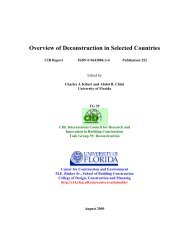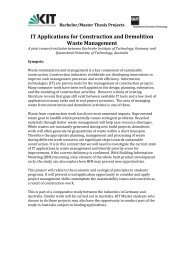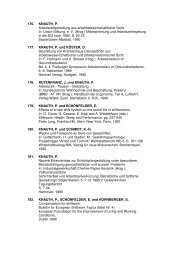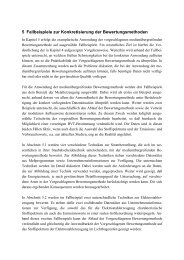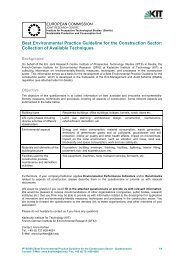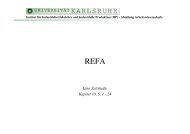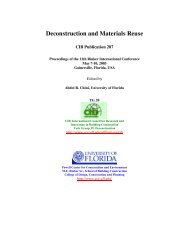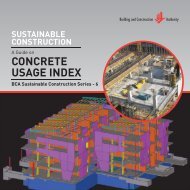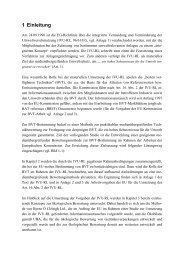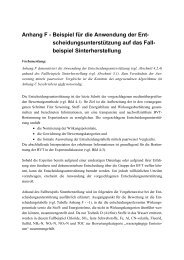Waste reduction final report -4 - Test Input
Waste reduction final report -4 - Test Input
Waste reduction final report -4 - Test Input
Create successful ePaper yourself
Turn your PDF publications into a flip-book with our unique Google optimized e-Paper software.
Discussion<br />
Treatment of the main construction waste materials is well advanced in Switzerland with a<br />
total recycling rate of about 80%. It seems that a further <strong>reduction</strong> of primary gravel use can<br />
only take place when the growth rate of new constructions will decrease. This process is<br />
sometimes called “from stock growth to stock management” or “from waste management to<br />
resource management”.<br />
However, it has to be recognised that the recycling rate is much lower in house building than<br />
in civil engineering. Material diversity and therefore the recycling or reuse challenges are<br />
huge when examining a building. A next step to make (building) construction waste more<br />
sustainable would be to identify appropriate materials and (new) technologies for treatment.<br />
Recycling of PVC materials is one positive example for this. It shows that considerable<br />
knowledge is already there; efforts to bring it to the respective people should be intensified.<br />
Sadly enough, helpful web pages such as www.ecobau.ch are not used by many planners and<br />
clients, even if it provides useful information to mitigate construction waste.<br />
Bottom up or top down, this is a well-known question when thinking about implementing<br />
sustainability. There have to be used both approaches in order to speed up new treatment<br />
ways of construction waste and to avoid waste in construction design. This process is still<br />
very slow in Switzerland, so that future work should concentrate on identifying important<br />
boosters to accelerating it. On the one hand, authorities can serve as exemplars or can point<br />
out the importance of sustainability. They can be supported by an adequate legal frame and<br />
decreed laws e.g. to prohibit landfilling of certain materials. Though, as to my opinion, laws<br />
and regulations can’t be the most important drivers of sustainable construction waste<br />
handling. Possibilities to bypass them are large in this industry. However, they are very<br />
important in order to give signalling effects, to start discussions on the topic and to lead waste<br />
handling in defined direction. [Lichtensteiger 2006] even suggests incorporating structures as<br />
resource users and resource donors in regional and national cadastres.<br />
Today, the awareness for sustainable construction waste handling and sustainable<br />
construction is very low among planners, clients and other people. Like in other sectors,<br />
information about these topics should be brought to the population (don’t forget that 2/3 of all<br />
investments in construction engineering are made by private awarding authorities). Ideally,<br />
this would establish a certain force on planners and raise the willingness to include life cycle<br />
costing into calculations for a new structure or in refurbishment works.<br />
Companies do what is profitable, this is how reality works. An important instrument in this<br />
view is Life Cycle Costing – a way of looking at a product’s life cycle taking into account<br />
external and extra costs, e.g. emerging for renewal of material parts. This is also what could<br />
convince private people to include sustainable considerations when planning a building.<br />
However, high costs at the beginning of a building’s life can be an obstacle to include all<br />
sustainable thoughts. Financial support by the cantons (which is today already partly given)<br />
could help to mitigate this problem.<br />
Furthermore, planners have to be reached in a much broader manner. Apparently, in<br />
Switzerland today only very few architects take construction waste handling into their<br />
considerations. Admittedly, complexity of construction materials is high and many other<br />
points have to be thought of in planning. In addition, recycling construction materials or wellseparable<br />
materials are not always available in a reasonable distance. This fact was also<br />
recognised when buildings were made following the MINERGIE-ECO® guidelines: All in<br />
all, it can’t always be claimed that such a building is more sustainable than another, this e.g.<br />
113



